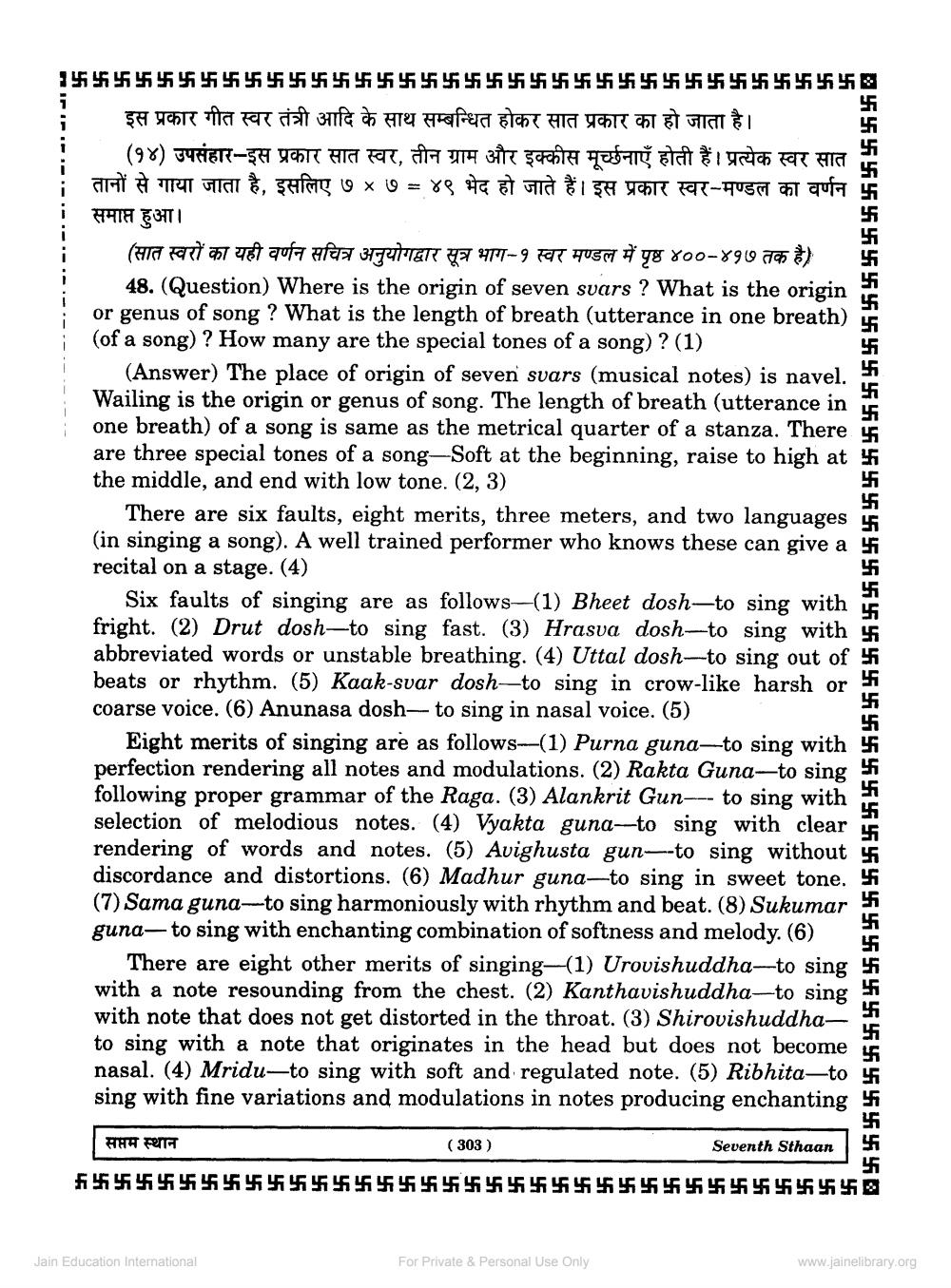________________
4 4
4 4
455 456 457 455 456 4
457
1545454545 4545454545454 455 456 457 455 456 457 451 455 456 457 411 414 415 416
इस प्रकार गीत स्वर तंत्री आदि के साथ सम्बन्धित होकर सात प्रकार का हो जाता है।
(१४) उपसंहार-इस प्रकार सात स्वर, तीन ग्राम और इक्कीस मूर्च्छनाएँ होती हैं। प्रत्येक स्वर सात तानों से गाया जाता है, इसलिए ७ x ७ = ४९ भेद हो जाते हैं। इस प्रकार स्वर-मण्डल का वर्णन है समाप्त हुआ।
(सात स्वरों का यही वर्णन सचित्र अनुयोगद्वार सूत्र भाग-१ स्वर मण्डल में पृष्ठ ४००-४१७ तक है)
48. (Question) Where is the origin of seven svars ? What is the origin or genus of song ? What is the length of breath (utterance in one breath) (of a song) ? How many are the special tones of a song) ? (1)
(Answer) The place of origin of seven svars (musical notes) is navel. Wailing is the origin or genus of song. The length of breath (utterance one breath) of a song is same as the metrical quarter of a stanza. There are three special tones of a song-Soft at the beginning, raise to high at the middle, and end with low tone. (2, 3)
There are six faults, eight merits, three meters, and two languages (in singing a song). A well trained performer who knows these can give a recital on a stage. (4)
Six faults of singing are as follows-(1) Bheet doshto sing with it fright. (2) Drut dosh-to sing fast. (3) Hrasva dosh-to sing with 4 abbreviated words or unstable breathing. (4) Uttal dosh-to sing out of beats or rhythm. (5) Kaak-svar doshto sing in crow-like harsh or coarse voice. (6) Anunasa dosh- to sing in nasal voice. (5)
Eight merits of singing are as follows--(1) Purna guna-to sing with perfection rendering all notes and modulations. (2) Rakta Guna—to sing following proper grammar of the Raga. (3) Alankrit Gun--- to sing with selection of melodious notes. (4) Vyakta guna—to sing with clear rendering of words and notes. (5) Avighusta gun--to sing without 4 discordance and distortions. (6) Madhur guna-to sing in sweet tone. (7) Sama guna-to sing harmoniously with rhythm and beat. (8). guna- to sing with enchanting combination of softness and melody. (6)
There are eight other merits of singing-(1) Urovishuddha--to sing with a note resounding from the chest. (2) Kanthavishuddha-to sing with note that does not get distorted in the throat. (3) Shirovishuddhato sing with a note that originates in the head but does not become nasal. (4) Mridu—to sing with soft and regulated note. (5) Ribhita—to sing with fine variations and modulations in notes producing enchanting
455 456 457 455 456 455 456 457 455 456 455 456 455 456
454 455 456 455 456 457 455 456 457 455 456 457 455 456 455 456 457 454
| सप्तम स्थान
( 303 )
Seventh Sthaan
Jain Education International
For Private & Personal Use Only
www.jainelibrary.org




